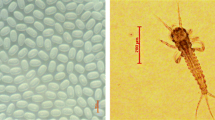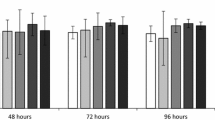Abstract
Pesticides have been major contributors to environmental pollution and they are now widely distributed in aquatic environments. Zooplankters are frequently used as test animals to detect aquatic contaminants because of their sensitivity and ecological importance. We investigated the effect of a 7-day exposure to four commonly used pesticides (diazinon, fenitrothion, methoprene and isoprothiolane) on reproduction of the rotifer Brachionus plicatilis. Pesticide concentrations of 3–7 times lower than the 24-h 50% lethal concentration (24-h LC50) were tested to determine the ‚no observed effect’ concentration (NOEC), ‚lowest observed effect’ concentration (LOEC), and the ‚50% effective’ concentration (EC50) on specific growth rate (r), sexual reproduction, fertilization, resting egg production, and hatchability of resting eggs. Results showed that the lowest EC50 value of r, mixis, fertilization, and resting egg production of 1.4 μM for diazinon was 63 times lower than its 24-h LC50 of 88.4 μM, while for fenitrothion it was 66 times (3.5 and 229.8 μM, respectively). For isoprothiolane, the lowest EC50 value of r, mixis, fertilization, and resting egg production of 8.9 μM was 25 times lower than its 24-h LC50 of 220.7 μM, while for methoprene was 37 times (2.7 and 100.8 μM, respectively). In all pesticides, hatching rate of resting eggs consistently gave the lowest EC50 values which is about 2–40 times lower than the lowest EC50 of r, mixis, fertilization, and resting egg production. Hatchability of resting eggs therefore is the most sensitive parameter in detecting effects of pesticides exposure in rotifer B. plicatilis.
Similar content being viewed by others
References
American Society of Testing and Materials (ASTM), 1998. Standard guide for acute toxicity test with the rotifer Brachionus. In Allen, R. F., (ed.), Annual Book of ASTM Standards, Section II-Water and Environmental Technology. American Society of Testing Materials, West Conshohocken, PA, 837–843
Carmona (1993) ArticleTitleRelationships between mixis in Brachionus plicatilis and preconditioning of culture medium by crowding Hydrobiologia 255/256 145–152 Occurrence Handle10.1007/BF00025832
D. J. Ecobichon R. M. Joy ( 1994) Organophosphorus esters insecticides D. J. Ecobichon R. M. Joy Z. B. Alfassi (Eds) Pesticides and Neurological Diseases CRC Press Florida 171–249
M. D. Ferrando E. Sancho E. Andreu-Moliner (1996) ArticleTitleChronic toxicity of fenitrothion to an algae (Nannochloropsis oculata), a rotifer (Brachionus calyciflorus), and the cladoceran (Daphnia magna) Ecotoxicology and Environmental Safety 35 112–120 Occurrence Handle10.1006/eesa.1996.0090 Occurrence Handle8950533
Fukushima M., Y. Yamaguchi, A. Yamada, 1995. Temporal trend of pesticide pollution in river water as a potable water. In IWSA Specialized Conference on Advance Treatment and Integrated Water System Management into the 21st Century, 158–163
A. Hagiwara A. Hino R. Hirano (1988) ArticleTitleEffects of temperature and chlorinity on resting egg formation in the rotifer Brachionus plicatilis Nippon Suisan Gakkaishi 54 569–575
A. Hagiwara A. Hino (1989) ArticleTitleEffect of incubation and preservation on resting egg hatching and mixis in the derived clones of the rotifer Brachionus plicatilis Hydrobiologia 186/187 415–421 Occurrence Handle10.1007/BF00048940
A. Hagiwara A. Hino (1990) ArticleTitleFeeding history and hatching of resting eggs in the marine rotifer Brachionus plicatilis Nippon Suisan Gakkaishi 56 1965–1971
A. Hagiwara A. Hino K. Nishi A. Imaizumi K. Hirayama (1993) ArticleTitleMass production of rotifer Brachionus plicatilis resting eggs in 50 m3 tanks Nippon Suisan Gakkaishi 59 93–98
A. Hagiwara H. Hoshi F. Kawahara K. Tominaga K. Hirayama (1995) ArticleTitleResting eggs of the marine rotifer Brachionus plicatilis Müller: development, and effect of irradiation on hatching Hydrobiologia 313/314 223–229 Occurrence Handle10.1007/BF00025955
J. A. Lindley P. Donkin S. V. Evans C. L. George K. F. Uil (1999) ArticleTitleEffects of two organochlorine compounds on hatching and viability of calanoid copepod eggs Journal of Experimental Marine Biology and Ecology 242 59–74 Occurrence Handle10.1016/S0022-0981(99)00094-5
H. S. Marcial A. Hagiwara T. W. Snell (2002) ArticleTitleEffect of known and suspected endocrine disrupting chemicals on the demographic parameters of the copepod Tigriopus japonicus Fisheries Science 68(Suppl. I) IssueIDsuppl. I 863–866
T. Naess (1991) ArticleTitleTolerance of marine calanoid resting eggs: effects of freezing, dessication and Rotenone exposure – a field and laboratory study Marine Biology 111 455–459 Occurrence Handle10.1007/BF01319418
B. L. Preston T. W. Snell T. L. Robertson B. J. Dingmann (2000) ArticleTitleUse of freshwater rotifer Brachionus calyciflorus in screening assay for potential endocrine disruptors Environmental Toxicology and Chemistry 19 2923–2928 Occurrence Handle10.1897/1551-5028(2000)019<2923:UOFRBC>2.0.CO;2
B. L. Preston T. W. Snell (2001) ArticleTitleFull life-cycle toxicity assessment using rotifer resting egg production: implications for ecological risk assessment Environmental Pollution 114 399–406 Occurrence Handle10.1016/S0269-7491(00)00232-3 Occurrence Handle11584638
P. Radix G. Severin K. W. Schramm A. Kettrup (2002) ArticleTitleReproduction of Brachionus calyciflorus (rotifer) for the screening of environmental endocrine disrupters Chemosphere 47 1097–1101 Occurrence Handle10.1016/S0045-6535(01)00335-6 Occurrence Handle12137043
D. H. Ross D. Judy B. R. Jacobson Howell (1994) ArticleTitleMethoprene concentrations in freshwater microcosm treated with sustained-release Altosid formulations Journal of the American Mosquito Control Association 10 202–210
M. Sánchez M. D. Ferrando E. Sancho E. Andreu (1999) ArticleTitleAssessment of the toxicity of a pesticide with a two-generation reproduction test using Daphnia magna Comparative Biochemistry and Physiology Part C 124 247–252
F. Sehnal (1983) Juvenile hormone analogues R.␣G. H. Downer H. Laufer (Eds) Endocrinology of Insects Alan R. Liss New York, 657–672
T. W. Snell (1986) ArticleTitleEffect of temperature, salinity and food level on sexual and asexual reproduction in Brachionus plicatilis (Rotifera) Marine Biology 92 157–162 Occurrence Handle10.1007/BF00392832
T. W. Snell M. J. Carmona (1995) ArticleTitleComparative toxicant sensitivity of sexual and asexual reproduction in the rotifer Brachionus calyciflorus Environmental Toxicology and Chemistry 14 415–420
T. W. Snell C. R. Janssen (1995) ArticleTitleRotifers in ecotoxicology: a review Hydrobiologia 313/314 231–247 Occurrence Handle10.1007/BF00025956
Snell, T. W., M. Serra & M. J. Carmona, 1999. Toxicity and sexual reproduction in rotifers: Reduced resting egg production and heterozygosity loss. In Forbes, V. E. (ed.) Genetics and Ecotoxicology. Taylor and Francis: 169–185.
T. W. Snell M. Serra (2000) ArticleTitleUsing probability of extinction to evaluate the ecological significance of toxicant effects Environmental Toxicology and Chemistry 19 2357–2363 Occurrence Handle10.1897/1551-5028(2000)019<2357:UPOETE>2.3.CO;2
C. E. Stephan J. R. Rogers (1985) Advantages of using regression analysis to calculate results of chronic toxicity test R. C. Bahner D. J. H. Hansen (Eds) Aquatic Toxicology and Hazard Assessment: Eight Symposium American Society for Testing and Materials Philadelphia, 328–339
M. Sudo T. Kunimatsu T. Okubo (2002) ArticleTitleConcentration and loading of pesticide residues in Lake Biwa basin (Japan) Water Research 36 315–329 Occurrence Handle10.1016/S0043-1354(01)00196-8 Occurrence Handle11766809
Zar J. H., 1999. Biostatistical Analysis, Vol. 4. Prentice Hall, New Jersey, 663 pp
Author information
Authors and Affiliations
Corresponding author
Rights and permissions
About this article
Cite this article
Marcial, H.S., Hagiwara, A. & Snell, T.W. Effect of Some Pesticides on Reproduction of Rotifer Brachionus plicatilis Müller. Hydrobiologia 546, 569–575 (2005). https://doi.org/10.1007/s10750-005-4302-3
Issue Date:
DOI: https://doi.org/10.1007/s10750-005-4302-3




